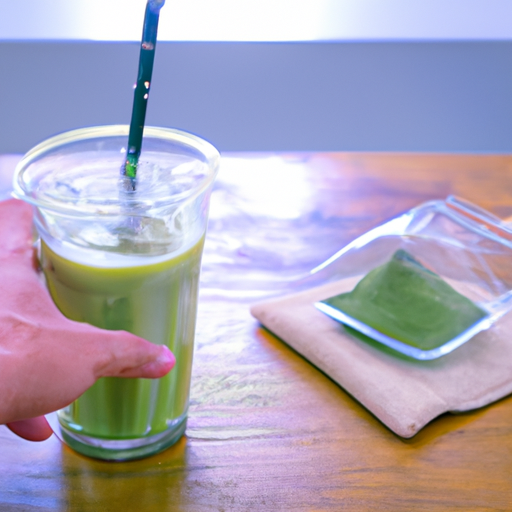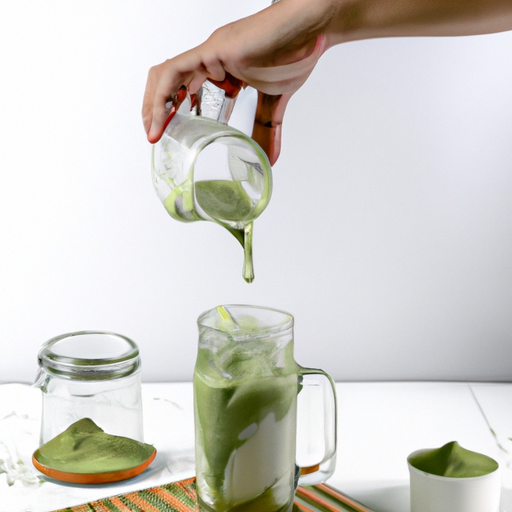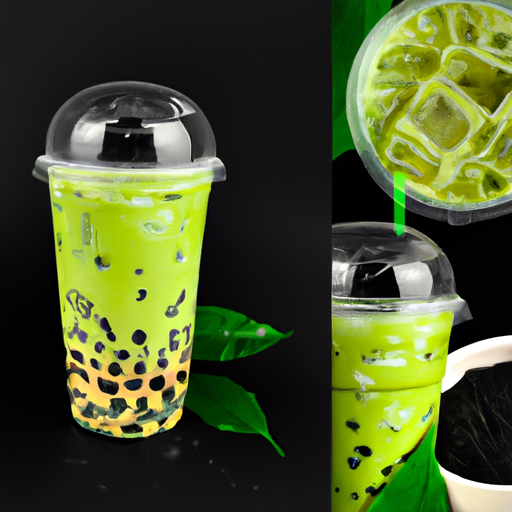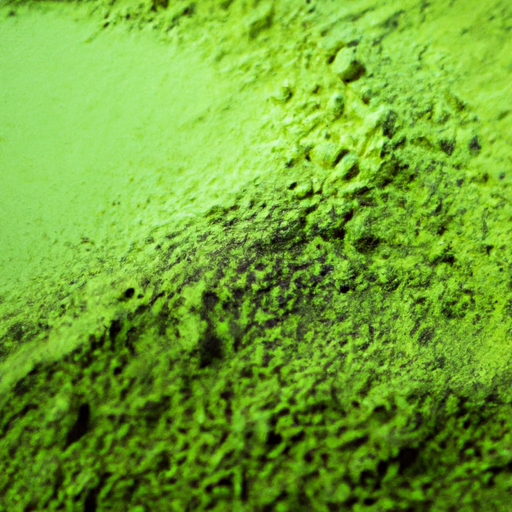As a tea enthusiast, the vivid green hue and distinct taste of matcha have always captivated me. This green tea powder has seen a surge in popularity lately, much of it owing to its health advantages and its application in various culinary dishes.
But have you ever wondered where matcha comes from and how it is made?
Matcha has its origins in Japan, where it has been a part of traditional tea ceremonies for centuries. The process of growing and processing the tea leaves to create matcha powder is a meticulous and time-consuming one, involving specific techniques and equipment.
In this article, we will explore the journey of matcha from the tea plant to your cup, delving into the fascinating world of matcha production, grades, and cultural significance.
Key Takeaways
- Matcha originates from Japan and has been a part of traditional tea ceremonies for centuries.
- Matcha is made from whole tea leaves that have been ground into a fine powder, providing all the nutrients and benefits from the entire tea leaf.
- Shading is a key step in creating the rich and smooth flavor of matcha, and it reduces the amount of sunlight the tea plants receive, resulting in a greener color and sweeter taste.
- Matcha contains a higher concentration of caffeine than other teas, but it is released into the body more slowly, providing a steady energy boost without the jitters.
Overview of Matcha’s Popularity and Health Benefits
You’ve probably heard that matcha is all the rage these days, and it’s no wonder – this vibrant green powder is packed with antioxidants and provides a steady, focused energy boost that will have you feeling like a superhero.
Not only is it healthy, but matcha is also versatile and can be used in a variety of recipes. From lattes to smoothies and even baked goods, matcha has become a staple ingredient in many kitchens.
Compared to other teas, matcha is unique in that it is made from whole tea leaves that have been ground into a fine powder. This means that when you consume matcha, you are getting all of the nutrients and benefits from the entire tea leaf, rather than just the water that has been steeped in traditional teas.
Matcha also contains a higher concentration of caffeine than other teas, but it is released into the body more slowly, providing a steady energy boost without the jitters.
Now, when it comes to where matcha comes from, it all starts with the tea plant: Camellia sinensis. This plant is native to China and is now grown in various parts of the world, including Japan, where most matcha is produced.
The leaves of the tea plant are harvested and then processed in a specific way to create matcha, which involves shading the plants for several weeks before harvest to increase chlorophyll production and enhance the flavor and texture of the leaves.
The Tea Plant: Camellia Sinensis
If you’re a tea lover, chances are you’ve heard of Camellia Sinensis – the plant from which all true tea originates. This evergreen shrub is native to East Asia and is cultivated in many parts of the world. Camellia Sinensis is a versatile plant that can be grown at various elevations and in different climates, producing a range of tea varieties with distinct flavors and aromas.
The cultivation techniques used for Camellia Sinensis can greatly impact the taste and quality of the tea. For example, the plant’s growing environment, including soil type and temperature, can affect the tea’s flavor profile. Additionally, the harvesting and processing methods used can also alter the taste of the tea.
Overall, Camellia Sinensis is a fascinating plant that has been cultivated for centuries. Its versatility in terms of cultivation techniques and the resulting range of tea varieties make it an important crop in many parts of the world.
In the next section, we’ll explore one of the most unique and important steps in the production of matcha – the shading process.
The Shading Process
As a tea enthusiast, I’ve come to appreciate the importance of the shading process in the production of high-quality tea.
The purpose of shading is to limit the amount of sunlight that reaches the tea leaves. This ultimately affects the flavor, aroma, and color of the final product.
The timing and duration of shading also play a crucial role in achieving the desired outcome. Different tea varieties require different levels of shading.
Purpose and Benefits of Shading
Shading the tea leaves before harvesting is a key step in creating the rich and smooth flavor of matcha. The purpose of shading is to reduce the amount of sunlight that the tea plants receive. This technique allows the plants to produce more chlorophyll and amino acids, resulting in a greener color and sweeter taste.
Some of the benefits of shading include:
- Increased sweetness: The shading process stimulates the production of amino acids, which are responsible for the sweet taste of matcha.
- Reduced bitterness: By reducing the amount of sunlight the tea plants receive, shading also reduces the production of catechins, which can cause bitterness in tea.
- Enhanced umami flavor: Umami is the savory taste that is characteristic of Japanese green teas. Shading helps to enhance this flavor by increasing the production of theanine, an amino acid that contributes to umami.
- Higher quality: Shading is a labor-intensive process that requires careful attention to detail. As a result, matcha that has been shaded tends to be of higher quality than matcha that has not.
Now that we understand the benefits and techniques of shading, let’s explore the timing and duration of this process.
Timing and Duration of Shading
The timing and duration of shading techniques have a significant impact on the flavor of matcha. Studies have shown that shading for a longer period results in a higher concentration of amino acids and a sweeter taste. The traditional shading process typically lasts for 20-30 days, but some farmers may experiment with shorter or longer durations to achieve their desired flavor profile.
The table below outlines the different timing and duration techniques used in matcha production and their corresponding impact on flavor. It is essential for matcha producers to carefully monitor the shading process to ensure the desired outcome and quality of the final product. Next, we will explore the next step in the matcha production process, harvesting the leaves.
| Technique | Duration | Flavor Impact |
|---|---|---|
| Traditional | 20-30 days | sweeter, richer |
| Shorter duration | 10-15 days | milder, less sweet |
| Longer duration | 35-40 days | stronger, more bitter |
Harvesting the Leaves
Harvesting matcha leaves is a laborious process, but the end result is a vibrant and flavorful tea that’s worth the effort. There are two primary methods for harvesting matcha leaves: hand-picking and machine harvesting.
Hand-picking is the traditional method and requires skilled laborers to carefully pluck the leaves by hand. This method is more costly than machine harvesting, but it allows for a higher quality product as the leaves are less likely to be damaged.
Machine harvesting, on the other hand, utilizes equipment such as mechanical harvesters and leaf blowers to collect the matcha leaves. This method is quicker and less labor-intensive, but it can result in a lower quality product as the leaves may be damaged during the harvesting process. Additionally, machine harvesting is not suitable for all tea farms as the terrain may not be conducive to the use of machinery.
Once the matcha leaves are harvested, they must be processed in order to produce the vibrant green powder that’s commonly associated with matcha. This process involves steaming, drying, and grinding the leaves into a fine powder.
The quality of the matcha powder is dependent on the quality of the leaves and the processing methods used. With proper harvesting and processing techniques, matcha can be produced with a smooth and rich flavor that’s highly sought after by tea connoisseurs.
Processing the Leaves
When processing matcha leaves, there are two key steps: steaming and drying, and sorting and grinding.
First, the leaves are steamed to stop fermentation and preserve their color and flavor. Then, they are dried and sorted based on their quality.
Finally, the leaves are ground into a fine powder using traditional stone mills to create the vibrant green powder that we know as matcha.
Steaming and Drying
To make matcha, you’ll need to start by steaming and drying the leaves until they’re ready to be ground into a fine powder. Steaming and drying is a crucial step in the process as it helps to preserve the flavor profile of the tea.
The steaming process involves applying high-pressure steam to the fresh leaves, which stops the oxidation process and helps to retain the tea’s natural flavors and nutrients.
After steaming the leaves, they are dried using a variety of methods, including air drying and oven drying. The drying process removes any remaining moisture from the leaves and helps to prevent the growth of bacteria.
Once the leaves are completely dry, they’re ready to be sorted and ground into a fine powder. This step is essential to producing a high-quality matcha, and it’s what gives the tea its distinctive flavor profile.
Sorting and Grinding
Now that the leaves have been steamed and dried, it’s time to sort and grind them into a fine powder, which is the key step in creating the delicious and nutritious matcha tea that so many people love.
Sorting techniques are crucial in this stage, as only the finest leaves will make it into the final product. The leaves are sorted based on their quality, size, and shape. The highest quality leaves will be used for ceremonial-grade matcha, while the lower quality leaves will be used for culinary-grade matcha.
Once the leaves have been sorted, it’s time to begin the grinding process. Grinding methods vary, but traditionally, the leaves are ground using a stone mill. This process can take up to an hour to grind just 30 grams of matcha powder.
The stone mills grind the leaves into a fine powder that is then sifted to ensure that there are no large particles left in the final product. The result is a vibrant green powder that is packed full of nutrients and antioxidants, making it a popular choice for health-conscious individuals.
As we move into the next section about grades of matcha, it’s important to note that the sorting and grinding techniques used play a significant role in determining the quality of the final product.
Grades of Matcha
You might be surprised to know that there are different grades of matcha, each with its own unique characteristics. Matcha grades are typically divided into ceremonial matcha and culinary matcha.
Ceremonial matcha is the highest grade and is made from the youngest tea leaves, which are hand-picked and stone-ground into a fine powder. This type of matcha is considered a luxury item and is often used in traditional Japanese tea ceremonies.
On the other hand, culinary matcha is made from older tea leaves that are machine-harvested and stone-ground. This grade of matcha is less expensive and is often used in cooking and baking. While culinary matcha is still high quality, it lacks the depth of flavor and smooth texture of ceremonial matcha.
It’s important to note that there are also different grades within each category of matcha. For example, within the ceremonial matcha category, there are different levels of quality based on factors such as the location where the tea was grown and the processing methods used.
Understanding the different grades of matcha can help you choose the right one for your needs and ensure that you’re getting the best possible flavor and texture.
Now, let’s dive into the world of traditional matcha ceremonies.
Traditional Matcha Ceremonies
During traditional matcha ceremonies, the focus is on the preparation and serving of ceremonial grade matcha, which is considered a luxury item. These ceremonies have a deep ceremonial significance that is rooted in Japanese culture.
They are often conducted in special tea rooms called chashitsu, which are designed to create a serene and peaceful atmosphere. The ceremonies are often led by a tea master or a host, who’s highly trained in the art of preparing matcha.
The preparation of matcha during a traditional ceremony is a highly choreographed ritual that involves specific movements and procedures. The tea is whisked with a bamboo whisk until it becomes frothy, and it is served in small ceramic bowls called chawan.
The tea is then passed around the room, and each guest is expected to take a sip and appreciate the flavor and aroma of the matcha. The process is designed to create a sense of harmony and tranquility among the guests.
Today, matcha has become increasingly popular outside of Japan, and it has found its way into modern culture. Matcha can now be found in many cafes and restaurants around the world, and it is often used as an ingredient in desserts, smoothies, and other beverages.
Despite its modern popularity, it’s important to remember the cultural practices and ceremonial significance that are associated with traditional matcha ceremonies.
Matcha in Modern Culture
Matcha has permeated modern culture, finding its way into desserts, smoothies, and other beverages in cafes and restaurants around the world. Matcha lattes have become a popular alternative to coffee, with their unique, earthy flavor and reported health benefits. Matcha powder is also a common ingredient in various desserts, such as cakes, ice cream, and even chocolate.
The rise of matcha in modern culture has also led to new innovations in the way it is prepared and consumed. For example, matcha lattes can now be found in many coffee shops, often made with almond or oat milk for a dairy-free option. Matcha desserts have also become more creative, with chefs experimenting with unique flavor combinations and presentation styles.
While matcha has become a trendy ingredient in the culinary world, it is important to consider the sustainability and ethics of its production. As the demand for matcha continues to grow, it is crucial to ensure that the production methods are environmentally friendly and that workers are treated fairly. These issues will be discussed in more detail in the subsequent section about sustainability and ethics in matcha production.
Sustainability and Ethics in Matcha Production
As someone who values sustainable and ethical practices in food production, I find it important to discuss the impact of matcha production on the environment, as well as the fair trade and labor practices involved.
Matcha cultivation requires specific environmental conditions and practices that must be carefully managed to avoid negative impact on surrounding ecosystems.
Additionally, it’s crucial to consider the working conditions and treatment of laborers in the matcha industry, and ensure that fair trade principles are being upheld.
Environmental Impact
You might be surprised to learn that the production of matcha can have a significant environmental impact. Here are some ways that matcha production can affect the environment:
-
Deforestation: In order to cultivate tea plants for matcha, forests are often cleared to make room for tea plantations. This can have devastating effects on local ecosystems and wildlife.
-
Water usage: The production of matcha requires a significant amount of water, which can put a strain on local water resources. In some cases, water usage for tea production has led to water scarcity in nearby communities.
-
Pesticide use: In order to protect tea plants from pests and diseases, farmers often use pesticides. These chemicals can have negative effects on the environment and human health.
Despite these environmental concerns, the economic impact of matcha production and its cultural significance cannot be ignored. However, it’s important for producers and consumers to be aware of the potential environmental impact and take steps to mitigate it.
Moving into the subsequent section about fair trade and labor practices, it’s important to consider not only the environmental impact of matcha production but also the social impact.
Fair Trade and Labor Practices
After discussing the environmental impact of matcha production, it’s important to address the human impact as well.
Fair trade certification and labor standards are crucial components of ensuring that the production of matcha is not only environmentally sustainable, but socially responsible as well.
Fair trade certification is a system that ensures that farmers and workers are paid fairly and have safe working conditions. This certification also requires that producers meet certain environmental standards, further promoting sustainability.
By supporting fair trade matcha, consumers can feel confident that their purchase is not contributing to unfair labor practices or environmental harm. Additionally, prioritizing fair trade matcha can encourage producers to adopt better labor and environmental practices, creating a positive ripple effect throughout the industry.
Frequently Asked Questions
How long has matcha been consumed in Japan and how did it become so popular?
Matcha has a rich history in Japan and has been consumed for centuries. Its cultural significance can be traced back to the country’s ancient tea ceremonies, where it was prepared and served to guests as a symbol of hospitality and respect.
Over time, matcha became more widely available and eventually reached a level of popularity that extends far beyond Japan’s borders. Today, it is enjoyed in a variety of ways, from traditional tea ceremonies to modern drinks and desserts. Its unique flavor and health benefits have made it a favorite among those seeking a natural and refreshing alternative to coffee or other caffeinated beverages.
Overall, the history and cultural significance of matcha are a testament to its enduring appeal and its place as a beloved part of Japan’s rich cultural heritage.
Are there any specific regions in Japan known for producing high quality matcha?
When it comes to high quality matcha, there are definitely specific regions in Japan that are known for their exceptional production and cultivation techniques. Matcha production is an art form in Japan, and different regions have their own unique methods for growing and processing the tea leaves.
For example, Uji in Kyoto is known for producing some of the highest quality matcha in the world, thanks to its ideal climate and soil conditions. The tea grown in Uji has a distinct flavor profile that is prized by tea enthusiasts around the globe.
Other regions, like Shizuoka and Kagoshima, also have their own unique approaches to matcha cultivation, resulting in teas with different flavor profiles. Whether you prefer a more vegetal or umami-rich matcha, there is a region in Japan that can offer you the perfect cup.
Can matcha be grown and produced in other parts of the world besides Japan?
Interestingly, matcha production is no longer limited to Japan. With the rise of the global matcha market, other countries have started to cultivate and produce matcha as well.
While Japan is still known for producing high-quality matcha, countries like China, South Korea, and even the United States have also begun to produce their own versions. However, it should be noted that traditional matcha production methods are still highly valued, and many tea experts believe that the best matcha still comes from Japan.
Nonetheless, the global expansion of matcha production has allowed more people to enjoy this beloved tea and has also brought about new variations and flavors. As someone who’s studied the matcha industry, I’m fascinated by the ways in which matcha production is evolving around the world.
Are there any health risks associated with consuming matcha?
Potential risks associated with consuming matcha are typically related to its high caffeine content. It’s important to be mindful of dosage recommendations, especially for individuals who are sensitive to caffeine or have underlying health conditions. Some potential risks include increased heart rate, high blood pressure, and insomnia.
However, it’s worth noting that matcha also contains a unique amino acid called L-theanine, which has calming properties that may help to counteract the negative effects of caffeine. As with any dietary supplement, it’s important to speak with a healthcare provider before adding matcha to your diet, especially if you’re taking medication or have a history of heart problems.
Additionally, it’s important to be aware of the potential interaction between matcha and caffeine, as consuming too much caffeine can lead to negative side effects. Overall, while matcha can offer a range of health benefits, it’s important to consume it in moderation and to be aware of any potential risks.
How does the taste of matcha differ based on the grade and quality of the leaves used?
When it comes to the taste difference of matcha, it heavily relies on the quality of the leaves used. Higher quality leaves tend to have a sweeter and smoother taste, while lower quality leaves can be bitter and astringent. This is because lower quality leaves often have a higher concentration of tannins and other compounds that contribute to a harsher taste.
In terms of leaf quality, matcha is typically graded based on factors such as color, texture, and appearance. The highest quality leaves are shade-grown and handpicked, resulting in a more delicate and nuanced flavor. Overall, the taste of matcha can vary widely based on the grade and quality of the leaves used. Therefore, it is important to choose a high-quality product for the best flavor experience.
Conclusion
In conclusion, as someone who’s always been fascinated by the world of tea, learning about the production process of matcha has been truly enlightening. It’s no wonder why matcha has become so popular in recent years, with its numerous health benefits and unique taste.
One interesting statistic that caught my attention is that in Japan, where matcha originated, there are over 1,000 tea shops that specialize in matcha and traditional tea ceremonies. This gives us a glimpse into the deep cultural significance that matcha has in Japan, and how it has been celebrated for centuries. It’s amazing to think that a simple cup of tea can hold so much history and tradition.
Overall, understanding where matcha comes from and how it is produced is not only fascinating, but also crucial in ensuring the sustainability and ethics of matcha production. As consumers, it’s important to be mindful of the products we consume and their impact on the environment and the people involved in their production.
Matcha is not just a trendy drink, but a beautiful tradition and art form that deserves our respect and appreciation.










